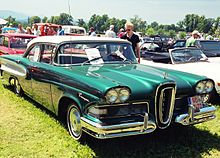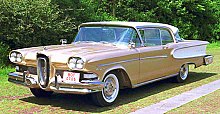Edsel
| Edsel | |
|---|---|

|
|
| owner | Ford Motor Company |
| Introductory year | 1957 |
| Products | Automobiles |
Edsel was an automobile brand of the Ford Motor Company . The brand, which was introduced in 1957, is still today a prime example of a failed product launch. The loss that Ford suffered from this failure is estimated at approximately $ 2 billion (when measured against the 2011 equivalent).
history
The US economy was booming from the early 1950s . Lots of people bought new and bigger cars. Ford's big competitors served the market with a colorful bouquet of brands: GM with Chevrolet , Buick , Pontiac , Oldsmobile and Cadillac , Chrysler with Plymouth , Dodge , DeSoto , Chrysler and Imperial . At Ford, there was only the Ford brand, which stood for cheap, robust utility cars, the somewhat more noble Mercury brand and the luxury brand Lincoln . Ford wanted a mid-range model for customers with high demands who wanted to spend more on it. Some managers, especially Robert S. McNamara , warned against this move, but Ford created a new department, which was then led by McNamara. The designer Roy Brown (born October 30, 1916 in Ontario, † February 24, 2013) was commissioned to design a car that should clearly stand out from the crowd. This succeeded although some details were deleted early because their construction was considered too expensive. The conspicuously narrow and tall radiator grille had to be widened to let in more air.
Much work has been done to find a sounding name for the new model. The name choice for the Ford Thunderbird , which had proven to be extremely popular and was one of Ford's great sales successes, had been made on the basis of extensive market research. Similar attempts were made for the new model. Name choice market studies were conducted in New York , Chicago, and Michigan ; There was an employee competition for the best model designation and Ford even approached the American poet Marianne Moore and asked her to suggest a name that symbolized elegance, speed, modern equipment and design. Ultimately, Ford had compiled no fewer than 10,000 possible names. Finally, against the wishes of the family, who did not want to see the name of a relative in the advertisement, the name Edsel was chosen relatively arbitrarily and spontaneously at a board meeting. They wanted to honor Edsel Ford , the only son of Henry Ford who died in 1943 and father of Henry Ford II . The name Edsel had been considered early on, but market research had shown that it was not well received by the public. In word association tests he was with terms like weasel (English for "weasel", but also for "sneaky person"), "pretzel" (English for "pretzel") or "dead cell" (English for "empty (dead) battery") ") has been connected. The head of public relations, C. Galle Warnock, who strictly rejected the name because he foresaw a negative effect on the sales success of the new model and would have preferred names such as Pacer , Ranger , Corsair or Citation instead , was unable to gain acceptance.
Even before the model appeared, Ford was doing intensive public relations work. For example, articles appeared in the US magazines Time and Life that celebrated the Edsel as a technological breakthrough. Production began in July 1957. The advertising brochure also announced Edsel as a car that had never been seen before. The new brand was officially presented on September 4, 1957. The series was available in a short version based on a Ford platform and a longer version based on Mercury, a total of 16 variants. On October 13, the CBS television station hosted an Edsel show that featured Bing Crosby , Frank Sinatra and Louis Armstrong . The media hype surrounding the new model initially paid off. Shortly after the model was presented, more than 3 million Americans had visited the sales rooms of Ford dealers. The real technical innovations that the model offered, however, were only self-adjusting brakes and an electrically opening engine hood. This was far less than the public expected.
The press, which at first had eagerly spread every rumor, no matter how small, was now disdainful of the new car. Among other things, the glove compartment was found to be too small. The main point of criticism, however, was the unusual radiator grille , which was supposed to be reminiscent of vehicles from the 1920s and 1930s. A few journalists praised it, but most found it only ridiculous: "Toilet seat" was another of the friendlier terms, one journalist wrote that with this grille the car looked like an Oldsmobile sucking a lemon. Some viewers associated the central part of the grille with the outer female genitalia . In addition, there were quality problems , as McNamara refused the model its own production facilities and the car was assembled in the factories of other Ford brands, and a poor supply of spare parts . The persistent problems led to the backronym "every day something else leaks", in English: "Every day something different is leaking".
At the same time, sales of the Edsel suffered from the fact that this car was expensive compared to the models of the competition and at the same time consumers began to demand increasingly smaller, less fuel-guzzling models. The Edsel also seemed comparatively expensive because it came on the market in September, two months before other car manufacturers launched their new models. The Edsel therefore competed against the 1957 models with their 1957 prices. Ford had also decided to bring the most expensive model of the noble first onto the market.
For the next model year, the design was defused and the model range was cut. Was the 1958 model yet alongside the production manufactured by Ford, is now summed up the Edsel production together in a factory in order to prevent the quality problem. That didn't help either, the Edsel sold much worse than expected. The model for 1960 was redesigned so that nothing reminded of the unfortunate design, the product range was reduced even further.
A few months after the start of the 1960s production, the end came from the top. Ford had planned to sell 200,000 to 300,000 vehicles annually so that the new brand would be in the black after two to three years. By the end of production, however, only 110,847 vehicles had been built. After the failure of the Edsel was foreseeable, McNamara was able to enforce his idea of an inexpensive compact car: the Falcon appeared in 1960 .
vehicles
| Model year | Models |
|---|---|
| 1958 | Bermuda , Citation , Corsair , Pacer , Ranger , Roundup , Villager |
| 1959 | Corsair , Ranger , Villager |
| 1960 | Ranger , villager |
literature
- Robert Daines: Edsel - The Motor Industry's Titanic , ISBN 1-873361-19-X
- Matt Haig: Brand Failures . Kogan Page Limited, London 2011, E- ISBN 9780749463007 .
Trivia
An Edsel converted into a rocket vehicle called "Weird Edsel" plays a role in the 1987 Commodore 64 computer game Maniac Mansion . The model matches the names of the main characters, who are Ed, Fred and Edna Edison; accordingly, the car is also called "Ed's Edsel". In the course of one possible solution, it is to be viewed while flying through space with the earth in the background.
The Simpsons episode "A brother of Homer" parodies the Edsel. Homer Simpson designs a car for his brother. The car does not meet the market's expectations, bears the proper name "The Homer" and leads the company into bankruptcy.
Web links
- Further information on Edsel (German and English)
- Comprehensive US website for the Edsel brand (English)
- Picture of a 1960s Edsel Ranger (promotional picture)
- English-language online replica of an Edsel dealer
- 1958 promotional video
Individual evidence
- ↑ "Famous Names" , The New Yorker , September 26 2011th
- ↑ Matt Haig: Brand Failures . Kogan Page Limited, London 2011, E- ISBN 9780749463007 , p. 14.
- ↑ Matt Haig: Brand Failures . Kogan Page Limited, London 2011, E- ISBN 9780749463007 , foreword
- ^ Edsel Chief Designer Roy Brown Dies at 96 , motortrend.com, February 28, 2013; Designer Ford's biggest flop overleden , telegraaf.nl, March 1st, 2013. Brown later also designed the Ford Cortina .
- ↑ Matt Haig: Brand Failures . Kogan Page Limited, London 2011, E- ISBN 9780749463007 , p. 16.
- ↑ http://www.washingtonpost.com/wp-dyn/content/article/2007/09/03/AR2007090301419_pf.html
- ^ A b c Matt Haig: Brand Failures . Kogan Page Limited, London 2011, E- ISBN 9780749463007 . P. 15.
- ↑ a b c d Matt Haig: Brand Failures . Kogan Page Limited, London 2011, E- ISBN 9780749463007 . P. 16.
- ↑ Matt Haig: Brand Failures . Kogan Page Limited, London 2011, E- ISBN 9780749463007 . P. 18.
- ↑ Lee Iacocca My American Dream - Talking Straight. 1988, ISBN 3-404-61175-6
- ↑ Maniac Mansion fan page
- ↑ The Homer on the Simpsons Wiki











